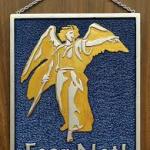I mentioned once before that I was surprised to find myself doubting the authenticity of a saying which the Jesus Seminar voted RED. I had always viewed their results as a fairly skeptical bare minimum.
The issue relates to some material that is in both Matthew and Luke (and thus attributed by most scholars to the ‘Q’ source). Matthew’s version, included in the Sermon on the Mount, is for that reason more famous. In fact, this part of Matthew’s Gospel has contributed two sayings to everyday English usage: ‘turn the other cheek’ and ‘go the extra mile’.
The version in Matthew’s Gospel includes additional details that allow the whole section to be interpreted as instructions for engaging in ‘passive resistance’ (it is not active civil disobedience in the strict sense). Matthew’s additional details (the right cheek, the law court) indicate a power distance that is not explicit in Luke.
Matthew also adds a third bit of teaching along the same lines, not found in Luke: when a Roman soldier compels you to go one mile (as they were allowed to do to non-citizens under Roman law), you should go two.
In each case, the person without power has an opportunity to reclaim a measure of dignity or control, or to make a point and challenge the injustice, rather than merely being passive or resorting to violence. The person being slapped humiliatingly with a backhanded slap can turn the left cheek and ask to be struck the way one strikes an equal. The person having his next to last piece of clothing away can offer the very last and through his nakedness shame the one to whom he is indebted. When the person carrying the soldier’s equipment passes the mile marker, he becomes a willing helper, a benefactor even, rather than someone under compulsion.
If such an interpretation were possible in only two of the cases Matthew depicts, I would have doubts. Its presence in all three suggests it is intentional on the part of either Matthew or his source.
The next question is whether Matthew’s or Luke’s version is the closest to what Jesus actually taught. Neither is intrinsically more probable – it is just as likely that Luke ‘toned down’ this controversial teaching as that Matthew added it. Indeed, the former might seem more likely, and a similar change could have occurred in the transmission of the teaching by someone who didn’t grasp the significance of the subtle message of these instructions.
Vishal Mangalwadi (in his book Trust and Social Reform, Hodder & Stoughton, 1989, pp.3-5) interprets Jesus’ acts of healing on the Sabbath and touching the unclean as acts of ‘civil disobedience’. The power establishment is shown by his actions to be more interested in ensuring Sabbath observance than in the individuals who for years, perhaps decade, have sat neglected and in need by the roadside.
The question I have is whether it is more likely that Matthew’s unique element, the part about ‘going the extra mile’, is his own contribution, or whether Luke has omitted it together with other details Matthew includes. Two things make the former somewhat more likely, in spite of the Jesus Seminar’s judgment to the contrary. One is the fact that Matthew regularly expands on and adds explanatory comments to the ‘Q’ material as well as in his use of Mark (just compare the beatitudes, the Lord’s prayer, or the saying about the ‘desolating sacrilige’, for instance). The other is the fact that Galilee was not under direct Roman rule in Jesus’ time, and so it is appropriate to wonder whether he would have offered teaching specific to that context.
What do you think? Does civil disobedience as a way of changing the world owe its greatest debt to Jesus, or to the creative adaptation of Jesus’ teaching by the author of Matthew’s Gospel.












